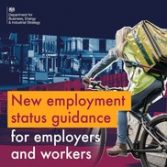Main Content

07/09/2022
New government guidance on employment status
The government has released new guidance to help employers to better understand the employment status of their teams.
Below, our HR partner Croner looks at the key implications for employers.
- There are different rights depending on whether an individual has the status of employee, worker or self-employed. As such, it’s important employers know what category their staff members fall into.
- The government confirmed that status tests will not be aligned for tax and employment purposes, they will stay different.
- Previous consultations looked at removing “worker” status and just having “employee” and “self-employed” status, but this was also rejected. As such, there are no major changes to the way status is currently assessed.
- However, status is, undoubtedly, one of the more difficult areas of employment law which organisations have to contend with.
- Due to the complexities involved with determining status, this new guidance will be welcome news for employers, which pulls together case law and other resources into one main document.
- Employers should keep in mind that the ramifications when status is applied incorrectly can be significant. In essence, it could lead to an employee missing out on statutory entitlements, such as sick pay, holiday pay and redundancy pay.
- Therefore, it is essential to ensure the correct status is applied from the commencement of employment, and regularly reviewed throughout the working period, to avoid tribunal claims and costs arising.
 The new government guidance, along with a checklist for employers, can be found here.
The new government guidance, along with a checklist for employers, can be found here.
HR helpline for DBA members
Croner provide an HR and Employment Helpline which DBA members can call to access practical, reliable HR and employment advice. Find out more here.
Image credit:
Towfiqu Barbhuiya | Unsplash
Gov.uk